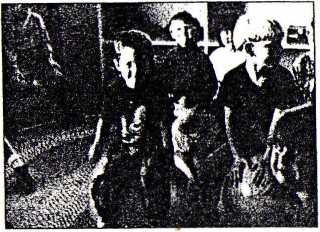img026

It is strongly recommended for the therapist to review safety instructions with the patient. *
Each patient should be given the following pages:
1. Suggested Sitting (Optimal) Posturę (page 27/28).
2. Suggested Inflation Instructions (See Appendix, page 193).
3. Cleaning and General Safety Instructions (See Appendix, page 194).
4. When applicable, give the instructions for commonly used pumps (See Appendix, page 195).
The bali is one of the most enjoyable, affordable and versatile exercise tools available. It has been used with Iow level neurological patients and acute pain patients as well as with healthy school children and world class athletes. These exercises can also be applied to people of all ages from toddlers to seniors and adapted for use with groups of differing abilities. There are very few contraindications or precautions for using the bali.
Con traindications
1. Patient fear. This is rare but can usually be overcome with demonstration and assurances from the therapist.
2. Complaints of increased pain. dizziness and/or impairment symptoms.
3. Disease or injury-speciftc exercise contraindications
Precautions
1. Guard patient adequately.
2. Patient will fatigue quicker as balance is constantly challenged.
3. Do not fatigue patient because they are enjoying exercises.
4. Monitor signs of cardiac distress.
5. Vertebral mobility exercises may flarę up symptoms of Degenerative Joint Disease.
Benefits: In clinicai use, the bali has been found to increase all of the following:
• Mobility
• Stability
• Balance
• Strength
• Circulation
• Coordination
• Postural Control
• Cardiovascular Fitness
• Vital Capacity of Lungs
• Nutrition to Body Structures
• Enjoyment and Compliance with Exercise Program ©1995 by Joannę Posner-Mayer, PT
The bali is unigue from other forms of exercise because it:
• activates the whole body to maintain balance.
• facilitates midline orientation.
• distributes body weight ovcr a relalivcly largc ycl dynamie base of support.
• creates two bases of support for the patient, the mobile bali ovcr the stable lloor.
• lowers the height of the body allowing equilibrium reactions and difllcull nuwement palterns to be elicited at a relatively safe distance from the floor.
• forces the body to work at the leve! of its weakcsl part because substitutions andA.tr compensations wilh a stronger part pushes alignment off center.
• integrates body strengthening, mobilizałion and coordination as they exist in functional activities.
Difficulty of the exercises can be inereased by making one or several of the following changes.
1. Decrease base of support
2. Increasc lever arm
3. Increasc distance traveled
4. Increasc speed of movcment
5. Add resistance- resistive band, free weights or manuał resistance Cornersely, difficulty ciul be redttced by making the opposile changes.
When a patient is given a home program using the bali, inforrn thent lliai evcn jusl silting on the bali is an exercise. Encourage them to, use the hall as a chair as often as possible to promote "active (unsupported) sitting", People will gencrally not jusl sil on the bali but will stan rocking. bouncing and slrctehing because it feels good. If they start bouncing for estended periods of limo in optimal posturę, they can impnwe the endurance of the postural ntusclcs. Vigorous bouncing com-bined willi arm and leg movcmenls will increasc hcart rato and can improce eardioeascular titness when performed at the proper level for an adequale amount ot tinie. 11 palients arc unable to set aside time during a busy day to perform their exerci.se program, suggest sitting on the bali whiie lalking on the phone or watching telecision. Keep in mind that unsupported sitting is an endurance actisi-ty. Therefore, start slowly and inerease the duration of activity as able. (II the patient performs an exercise during each television commercial. they will have easily completed many exerciscs).



There are numerous elcmcntary schools throughout Europę that have successfully replaced chairs with balls in clasśrooms to improvc posturę and reduce inactivity in young childrcn. This practice is being slowly introduced into American schools through therapists treating childrcn with special needs. Parents who are concerned about their childrens posturę have reported that requir-ing their children to sit on balls while watching television or playing video games is an effective way to encourage movement and exercise in otherwise inactive, kyphotic sitting postures.
© 1995 by Joannę Posner-Mayer, PT
25
Wyszukiwarka
Podobne podstrony:
Health Insurance It is strongly recommended that all students have health insurance that includes em
With lower infection rates and morę widespread testing, it is now feasible for the EU5 nations to us
5 (1921) BIG 4 The Big 4 is world renowncd for reliability. It is buiit throughout of the finest mat
12 M. Sajewicz et al. From this comparison it is apparent that for three of the five sagę species in
czytanie teksty The Futurę of ReadingGeorge Steiner It is hardly necessary for me to cite all the ev
10203 MR293R190?7 1 REMINDER OF THE PRIKCIPLE OF NASKING This method is essentially recommended for
00386 Te1730accb779852cc586c0c62f5e4d 390 Obenchain necessary, EN rescaling is still recommended be
jff 119 GLOSSARY The use of Japanese terms has been kept to a minimum in this book. It is an imposit
mbs 069 M BREATHING >Y>IKM phy.sicai culture, it is no wonder that the death-rate from consump
Physics.in Canada/10 auchorlzed to perform the duties of the Office for which he is so elected for t
S The message is sent all together; it is not broken up. The message arrives in the same order that
18457b7bd8a2a7cecef380c9782e01fd verb noun it is my recommendation to you as regar
więcej podobnych podstron